|
| | Budapest |
|
|
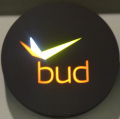
|
Budapest has long been on our shortlist, so when Dave and Megan
rented an apartment there for December, and then invited us to hang out with them at Christmas,
we moved faster than violin bows at a Mozart festival.
Their apartment is in the city center (where
the second ring intersects the Jewish quarter), handy to public transit and surrounded by inviting bars and
restaurants.
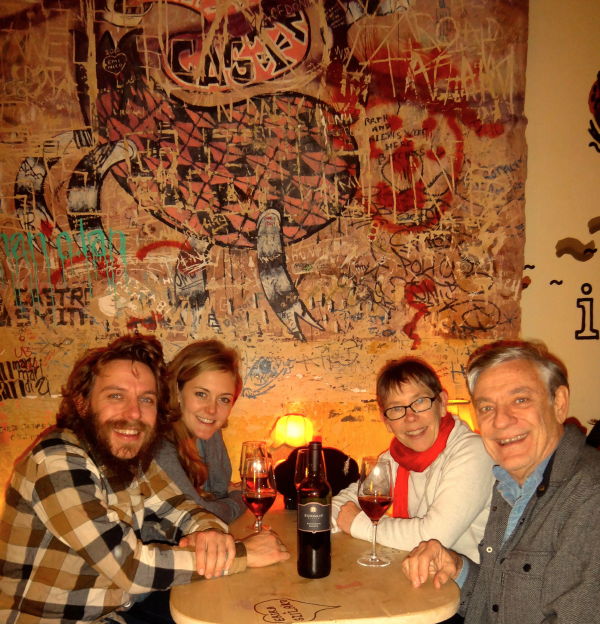
For example, Budapest is unique in having "Ruin Pubs," hip bars squatting in abandoned buildings. This is
Szimpla Kirt, the first of the Ruin Pubs. Because the plaster is cracked and stained, cover
it with graffiti; because the floor is ripped up, haul in a wrecked Mini and make a love seat out
of the engine compartment.
Bars are scattered over two floors, the music throbs, and
most patrons have the good sense not to bring the parents along! But, we're glad some do!
|
|
|
| Buda, Meet Pest |
For centuries, Budapest was two cities separated by the Danube, Buda on the west,
Pest on the east.
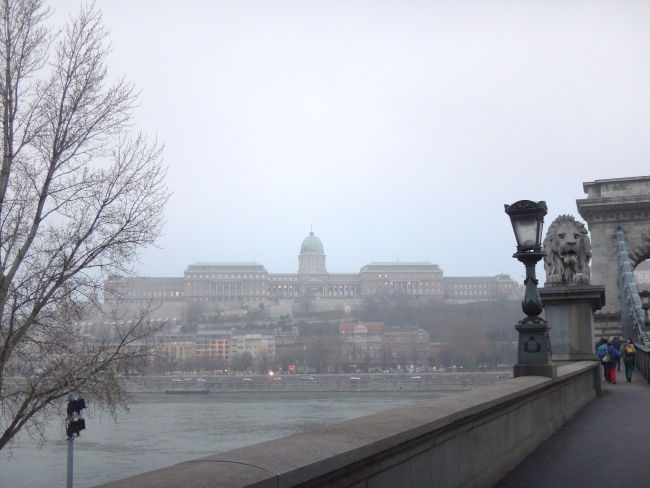
Buda from Pest
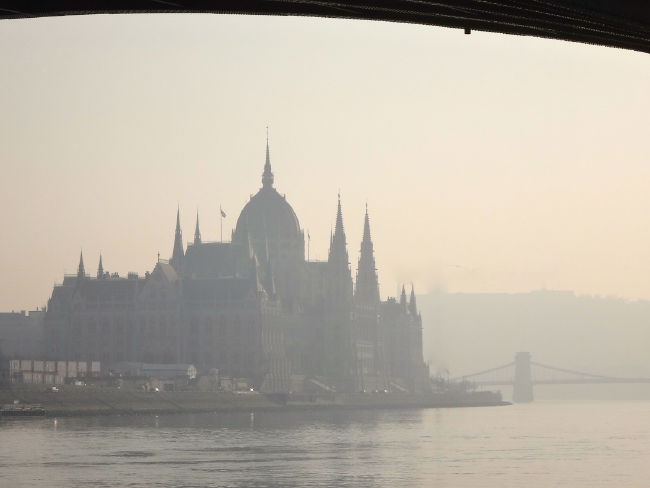
Pest from Buda
Eventually, the Chain Bridge was built in 1849, the first bridge crossing the Danube in Hungary.
With easy travel between the two, the cities joined in 1873.
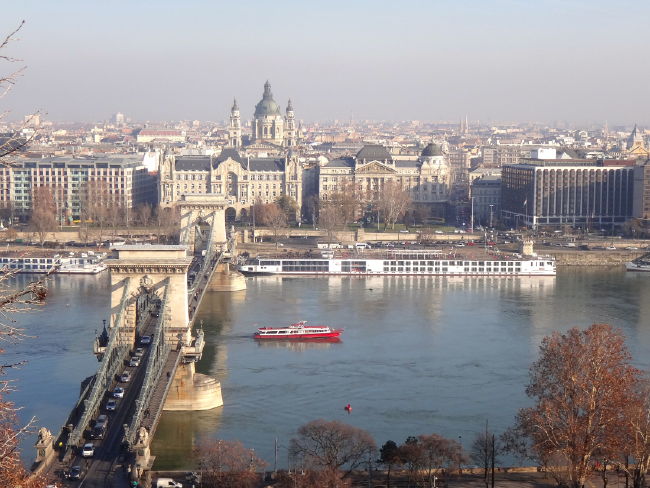
Budapest from Budapest
The Chain Bridge, largest in the world at the time of its construction, is curious to those of us
accustomed to cable suspension bridges. It is made out of 6 m (25') steel segments, grouped in 12s and
bolted together, presumably with a really big wrench.
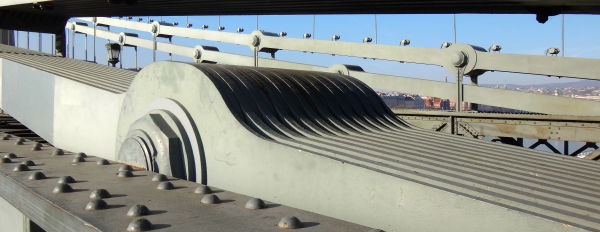
|
|
|
| Sound of Music |
Music is an important part of Christmas, and we were lucky enough to score tickets to two
performances: a concert of four J. S. Bach contatas presented by the Franz Liszt
Institute, and Johann Strauss' Die Fledermaus.
The Budapest Opera House is a stunning combination of marble, murals and gilded balconies.
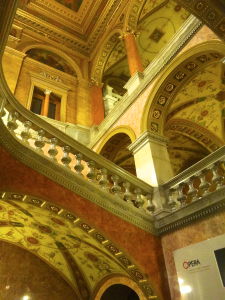 x
x
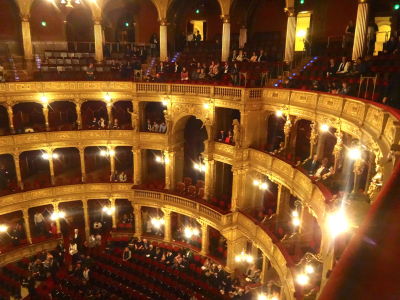
Interior of the Budapest Opera House
Die Fledermaus was a delight! The production of the second act, set at a grand
ball in the palace, was spectacular in both costumes and set design features. Most impressive
were the opera house's acoustics and how fully the soprano (green gown) filled it with her gorgeous voice.
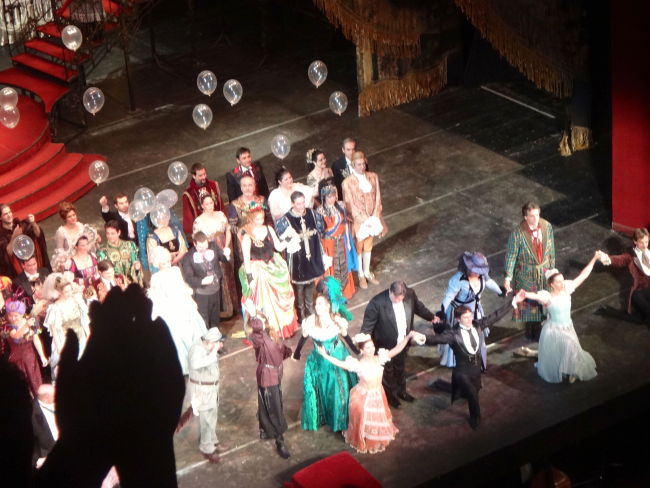
Bravo!
At the Bach concert we sat behind the orchestra in seats normally reserved for the choir;
this music required only a 25 member orchestra, and 24 member choir, so there was extra space.
This was an amazing opportunity to enjoy beautiful music, while watching an orchestra from the
musicians' perspective, hearing the harpsichord clearly, and noticing who in the audience nodded
off to sleep.

One Note Tune
The concert was a great place for people watching ...
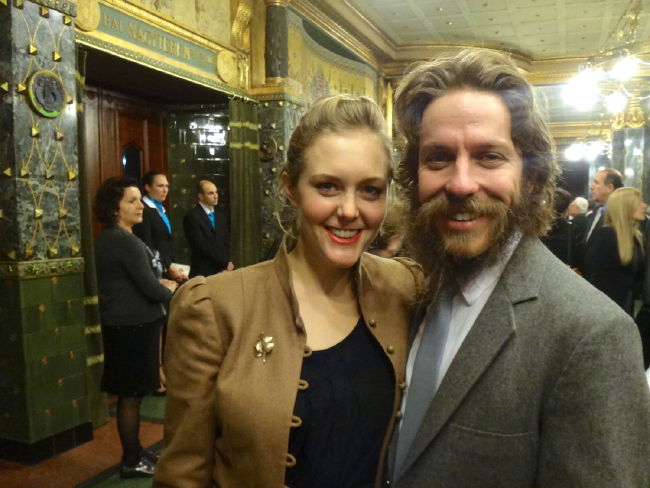
Megan and Dave
|
|
|
| Synagogue |
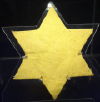 Over the last few centuries
the residents of Budapest have generally been welcoming to Jews. (Of course, the Nazi's record
in Hungary generally, and Budapest specifically is as hideous as expected.) The main
synagogue, second largest in the world (after NYC), is fascinating on several levels:
It has Christian elements, such as an enormous pipe organ, Moorish geometric design elements,
and standard Judaic elements. The Budapest Jews follow a mix of Orthodox
and Reformed theology. Over the last few centuries
the residents of Budapest have generally been welcoming to Jews. (Of course, the Nazi's record
in Hungary generally, and Budapest specifically is as hideous as expected.) The main
synagogue, second largest in the world (after NYC), is fascinating on several levels:
It has Christian elements, such as an enormous pipe organ, Moorish geometric design elements,
and standard Judaic elements. The Budapest Jews follow a mix of Orthodox
and Reformed theology.
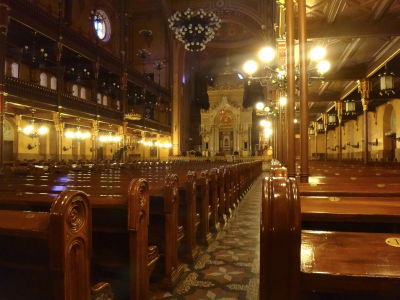 x
x
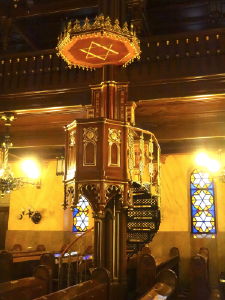
Budapest's Main Synagogue
In the synagogue complex are the Museum of Budapest's Jewish District and the Hungarian Holocaust Museum.
In the former was a fascinating video salvaged from grainy home movies of pre World War II life in the Jewish
district. Outdoors in the Raoul Wallenberg Park is a sculpture, Weeping Willow, on which the
names of people killed in the Nazi atrocities are inscribe on the leaves.

Weeping Willow
On the banks of the Danube is a moving sculpture by Gyula Pauer and Can Togay
memorializing the thousands of victims shot into the river by Arrow Cross militia men, members of a
Hungarian fascist party that terrorized the state for six months in 1944/45. Victims were told to
remove their shoes before being shot.
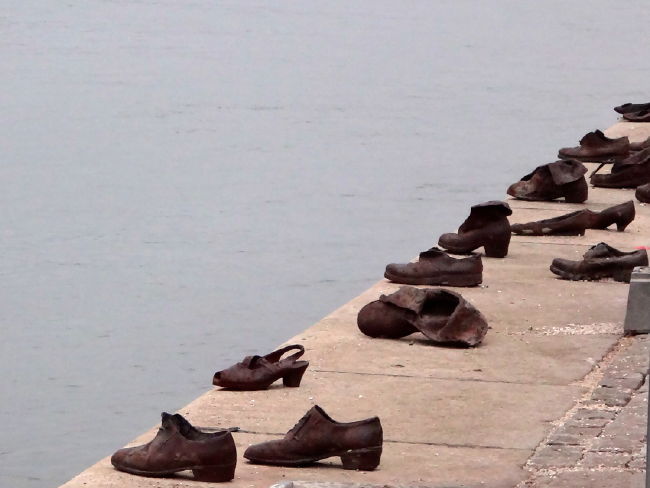
Shoes on the Danube Promenade
|
|
|
| Taking The Waters |
Evidence of human habitation in Budapest dates back to the 4th millenium BCE,
but it's probably much earlier ... because of the hot springs. The Romans, who called
Budapest Aquincum, built baths, and people have been soaking ever since. We visited
Rudas Baths and Széchenyi Baths. Rudas was built in 1500, and though rebuilt over the
centuries, it retains Moorish influences. [Steam precluded photos.]
Széchenyi retains its 19th century charm.
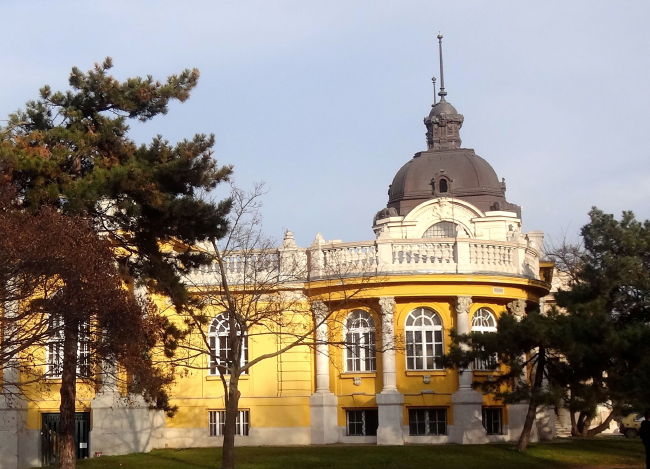
Széchenyi Baths
Hungary is home to more chess masters than anywhere else, so it's not surprising that
chess is played in the pools. (Though there is not enough resolution, the men below
and right of the red flag are playing chess.) Apparently, when your body is in 38° C (100.4° F)
water, you have a cool head for thinking!
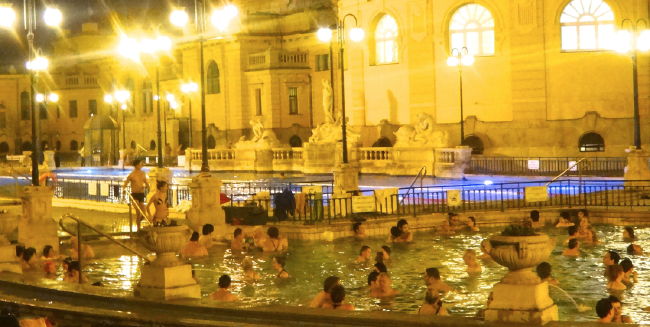
Winning Chess Even If Your King Is In Hot Water
Széchenyi has a dozen pools and innumerable saunas. In one circular pool a huge
current is created every 15 minutes that swirls bathers around
a smaller core pool.
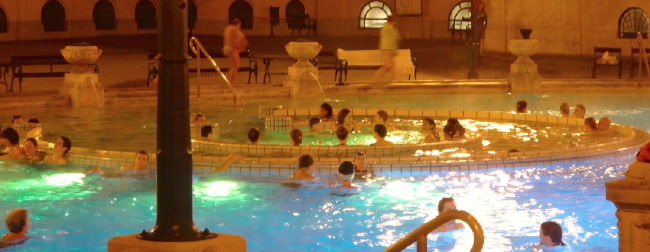
19th Century Water Park
|
|
|
| Christmas Market |
The Christmas market becomes a focal point for the city with food stalls, live music,
and holiday-related merchandise.

The Main Christmas Market
Handcraft Christmas ornaments are big sellers, though the logic of their design is often elusive.
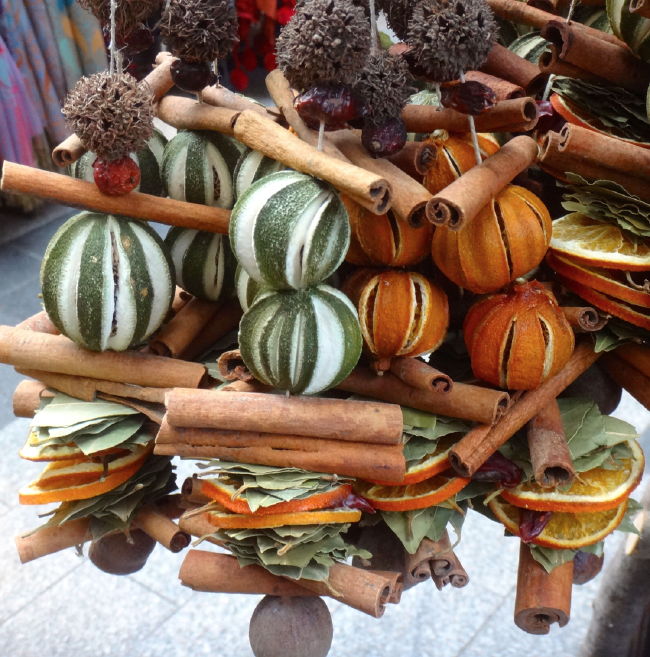
Needs More Cherries, Fewer Cinnamon Sticks
Food stalls are numerous. For us, gluhwein (forralt bor télire) was quite a hot item.
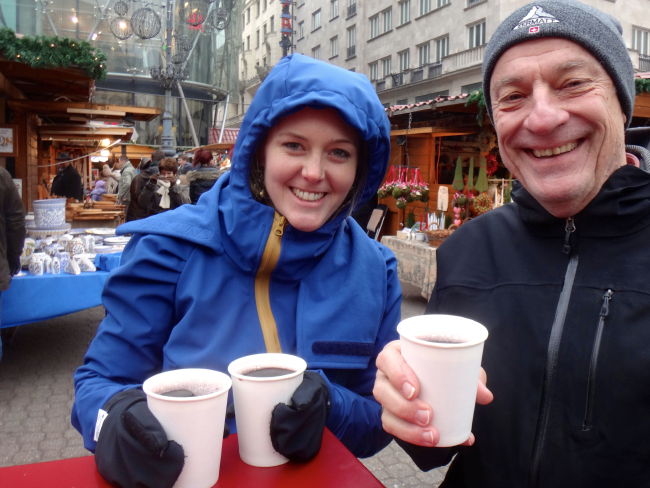
Gluhwein: The Preferred Use for Cinnamon
|
|
|
| Grand Market |
Budapest's Central Market is a joy to behold. It is huge in both size and choice.
Three floors of fruit, vegetables, meat, fish, pickles, bread and other foods.
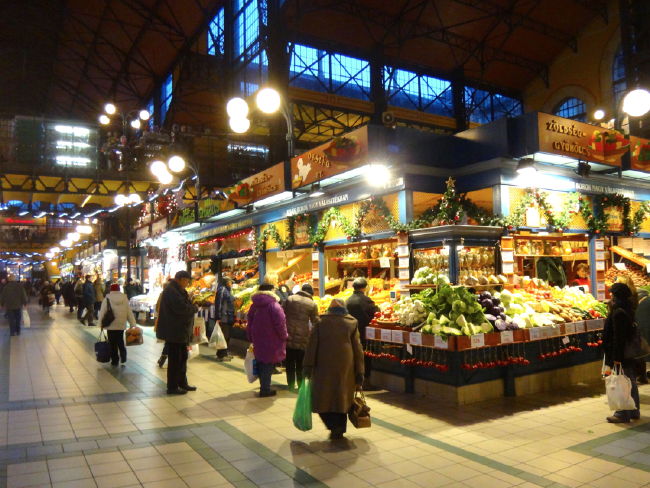
Wide Aisles and No Shopping Carts
In addition to the huge main market there are a half dozen branches scattered around the city; Dave
and Megan's bacon guy is at an equivalent market in their neighborhood.
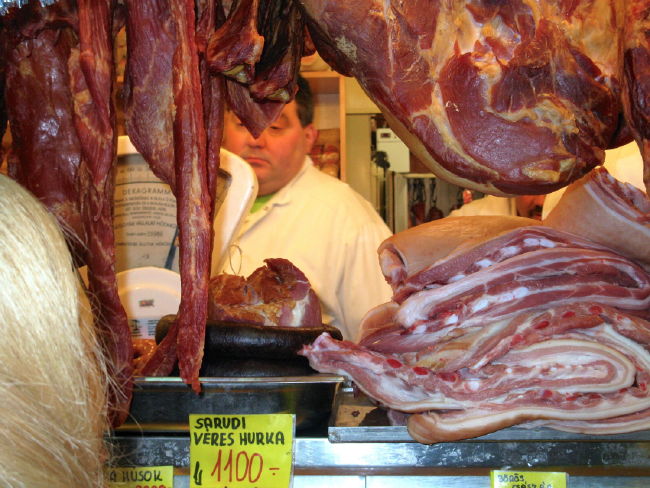
Meet Mr. Meat
|
|
|
| BUD Lite |
 Road signs in Europe use
language-independent graphics, of course. The sign for "Construction Ahead" has
long been an object of our ridicule because it looks to be saying "King Arthur Pulling
Sword from Stone Ahead". Then, as we were walking around the Parliament, in a split
second we saw the real-life instance of this icon! (Click pic.) Happily, in real life workmen
don't have to fit inside of triangles, and can stand up straight. Road signs in Europe use
language-independent graphics, of course. The sign for "Construction Ahead" has
long been an object of our ridicule because it looks to be saying "King Arthur Pulling
Sword from Stone Ahead". Then, as we were walking around the Parliament, in a split
second we saw the real-life instance of this icon! (Click pic.) Happily, in real life workmen
don't have to fit inside of triangles, and can stand up straight.

The Iconic Workman
Among the other curious things we saw were a truly ugly
fish and festive
Christmas pickles.
|
|
|
| Mistletoe |
The best reason to visit Budapest at Christmas is that mistletoe grows on the trees.

Following Christmas Tradition on Margaret Island, Christmas Eve
Thanks for the invitation ... the visit was awesome!
|
|
|
| |